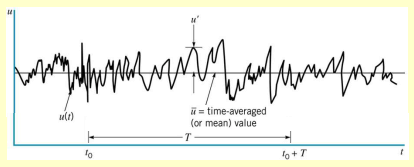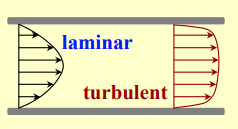Turbulent flow generally occurs when (around 4000) indicating that inertial forces greatly overpower viscous forces.
Velocity

In turbulent flow, velocity at a point fluctuates constantly over time. Thus, we introduce the concept of time-averaged velocity:
In turbulent analysis, the instantaneous velocity is decomposed into two components:
where is the mean (time-averaged) velocity and is the fluctuating velocity component. This decomposition allows us to separate the predictable average motion from the random, chaotic fluctuations.
An important property is that the time-average of the velocity fluctuations is zero:
This means that over a sufficiently long time, the positive and negative fluctuations cancel out, leaving only the mean velocity.
Velocity Profile Comparison

The velocity profile for turbulent flow is significantly different from that of laminar flow:
- In laminar flow, the profile is parabolic, with maximum velocity at the center and zero at the walls.
- In turbulent flow, the profile is much flatter in the center and only drops sharply near the walls. This is due to the strong momentum transfer caused by turbulent eddies.
Eddy Viscosity and Mixing Length
In laminar flow, viscosity () is a property of the fluid. In turbulent flow, we introduce the concept of eddy viscosity (), which represents the momentum transfer caused by turbulent eddies. This is not a physical property of the fluid but rather a model to account for the enhanced momentum mixing.

The expression for eddy viscosity is given by:
where:
- = Eddy viscosity
- = Fluid density
- = Mixing length (a measure of the average size of turbulent eddies)
- = Velocity gradient perpendicular to the flow
Eddy viscosity is much larger than molecular viscosity in turbulent flows, indicating far stronger momentum transfer. The term mixing length () represents the scale over which fluid elements mix chaotically, contributing to the energy dissipation and flattening of the velocity profile.
Momentum transfer in turbulent flows is very strong!
- The chaotic motion of eddies enhances the mixing of fluid layers.
- Momentum is transferred across streamlines more aggressively than in laminar flow.
- This increased momentum exchange is what leads to the flatter velocity profile and greater energy losses in turbulent conditions.